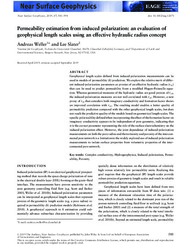Permeability estimation from induced polarization: an evaluation of geophysical length scales using an effective hydraulic radius concept
DOI: https://doi.org/10.1002/nsg.12071
Persistent URL: http://resolver.sub.uni-goettingen.de/purl?gldocs-11858/9175
Persistent URL: http://resolver.sub.uni-goettingen.de/purl?gldocs-11858/9175
Weller, Andreas; Slater, Lee, 2019: Permeability estimation from induced polarization: an evaluation of geophysical length scales using an effective hydraulic radius concept. In: Near Surface Geophysics, Band 17, 6: 581 - 594, DOI: 10.1002/nsg.12071.
 |
Dokument öffnen: |
Geophysical length scales defined from induced-polarization measurements can be used in models of permeability (k) prediction. We explore the relative merit of different induced-polarization parameters as proxies of an effective hydraulic radius (reff) that can be used to predict permeability from a modified Hagen–Poiseuille equation. Whereas geometrical measures of the hydraulic radius are good proxies of reff, the induced-polarization measures are not well correlated with reff. However, a new proxy of reff that considers both imaginary conductivity and formation factor shows an improved correlation with reff. The resulting model enables a better quality of permeability prediction compared with the other geophysical length scales, but does not reach the predictive quality of the models based on geometrical length scales. The specific polarizability defined when incorporating the effect of the formation factor on imaginary conductivity appears to be independent of pore geometry, indicating that it is the correct parameter representing the role of the surface electrochemistry on the induced-polarization effect. However, the joint dependence of induced-polarization measurements on both the pore radius and the tortuosity and porosity of the interconnected pore network is a limitation to the widely explored use of induced-polarization measurements to isolate surface properties from volumetric properties of the interconnected pore network.
Statistik:
ZugriffsstatistikSammlung:
This is an open access article under the terms of the Creative Commons Attribution License, which permits use, distribution and reproduction in any medium, provided the original work is properly cited.

